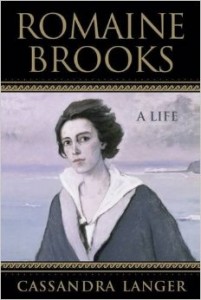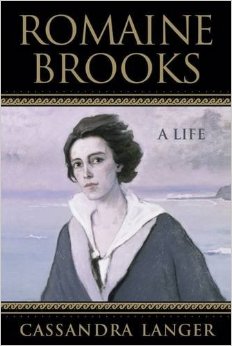 Romaine Brooks: A Life
Romaine Brooks: A Life
by Cassandra Langer
University of Wisconsin Press
168 pages, $26.95
BEATRICE Romaine Goddard (1874-1970)—better known as the American artist and heiress Romaine Brooks—does not at first strike one as being cursed. She grew up in a family of great wealth, inheriting at age 28 a small fortune from her mother, Ella Waterman Goddard. She lived for almost seven decades more without material want, free to pursue her considerable artistic gifts wherever she wished—which meant Paris, Capri, Florence, and wherever else the sexually marginal but socially well-connected European set tended to gather.
But, as this biography makes fully clear, hers was generally a miserable existence, suggestive of the dark shadows found in Djuna Barnes’ 1936 novel Nightwood, about the Parisian lesbian demimonde of which Brooks was a part.
At age nineteen, Brooks made a clean break and, with a tiny stipend provided by Ella, moved to Rome to study art. It toughened her up: she was the only female student and scandalized her peers by insisting on attending sketch classes of the male nude. She moved to the queer island paradise of Capri—as later celebrated in novels such as Norman Douglas’ South Wind (1917) and Compton Mackenzie’s Extraordinary Women (1928), in which Brooks is portrayed as “Olympia Leigh”—but without money. Then, in Paris, she found herself literally starving, and had a nervous breakdown. When her brother died, despite all that had happened, Brooks tended to her despondent mother, who died just a year later. The fortune, which had been their grandfather’s, was divided between Brooks and her sister.

It was not, one might say, the making of Brooks, but rather her curse. For she had developed no sense of judgment regarding friends and acquaintances. She impulsively married a failed gay British musician and writer, John Ellingham Brooks, to save him from the destitution she had recently experienced. He immediately assumed the upper hand in the sexless relationship, speaking of “our” fortune, and reproaching her when she cropped her hair and bought masculine clothing. Romaine fled for London, and then for St. Ives, Cornwall, where she discovered in the granite rock and bleak landscapes the limited grey palette for which her portraits are known. Brooks’ greatest artistic inspiration, meanwhile, was certainly another American expatriate, James Whistler, whose portrait of his mother (1871) famously bore the title Arrangement in Grey and Black No. 1. Her other artistic fellow travelers were John Singer Sargent, yet another American expatriate, and Jacques-Émile Blanche.
It is striking how completely, on her return to Paris in 1905, Brooks was resistant to the Fauvist and then Cubist experimentation of Picasso, Matisse, and the entire metropolitan avant-garde. She realized that portraiture was her gift and embraced it, with acclaimed canvases of figures of Parisian society—but also a succession of risqué female nudes. Brooks’ head continued to be turned romantically by the unstable, delusional, or uncouth: from Gabriele D’Annunzio, the Italian libertine, poet, and later Fascist, to Ida Rubinstein, the dancer and actress with whom she had an affair, and whom she frequently painted. She was even briefly engaged to Lord Alfred Douglas, in his supposedly “reformed’ post-Wilde persona.
Sapphism, though, was truly her thing. Brooks fell in love with Natalie Barney just around the outbreak of World War I. This equally wealthy, but more modestly talented, poetess ran a celebrated literary salon, which saw serious women of letters such as Colette rub shoulders with hangers-on, such as Oscar Wilde’s niece, the drug-addicted Dolly. Dolly was one of a series of women lovers that Barney kept in tow throughout her fifty-year relationship with Brooks—which, in being so enduring, was as rare as it was unconventional. The two did not cohabit, and indeed Brooks spent much of her time in Italy, spurning the superficiality of the French capital and the circles in which Barney moved.
Brooks’ career continued to thrive until the mid-1920s, at which point she seemed simply to lose interest. She had made her artistic statement across two decades—and did not need her art to sell in order to live. She painted just four more portraits, although there was a brief period of activity in the 1930s, when she took up a bizarre form of “unconscious” figurative sketching for her own amusement—or, perhaps, therapy. She succumbed to various forms of real and imaginary illness—all consonant with her view of herself as “lapidé” (literally, “stoned to death,” like the accursed). Her last years were spent in a flat in Nice, whose remarkable views over the Côte d’Azur felt merely mocking, since Brooks was scarcely able to see. There was a sweet, improbable moment, however, when the 79-year-old Brooks met one Janine Lahovary on a street bench overlooking the Baie des Anges—and romance began again. But she died miserable, mistrustful, living modestly and refusing to see anyone: not even Barney, who tried to look after her even as Brooks turned on her in a final phase of paranoia.
Brooks’ life far outspanned her career as a significant artist, and this biography inevitably struggles with the over-extended “afterlife.” Cassandra Langer is keen to promote her subject’s legacy as a fine portrait artist—a thesis that is convincing, though the claim that she was “one of the most accomplished and innovative lesbian artists of all time” perhaps poses more questions than it answers. She was, in fact, like Blanche or the Italian portraitist Giovanni Boldini, gifted and even dazzling, but also somewhat monotonous in her painterly style—which, moreover, went from barely contemporary to utterly outmoded.
On her and Barney’s copious and well-illustrated fascist leanings and anti-Semitic views—despite Barney being a quarter Jewish—Langer is less sure-footed. Brooks dismissed the life and writings of the “uneducated Jew” Gertrude Stein, and both she and Barney spoke and wrote in this way without hesitation—as did many artists in this period. Langer asks: “Was she, like many others living under occupation during World War II, simply giving lip service to such sentiments to survive?” Well, yes and no. And is this answer enough? Langer seeks to contextualize Brooks’ “attraction to the erotics of power” as being somehow “related to her horrific childhood, the trauma of modernization, and her own self-interests,” which sounds suspiciously like special pleading. Her contemporary, the author Bryher, spoke of Brooks being “a bit muddled over the Mussolini affair.” But political naïveté is still a choice, not a condition, and Brooks could see in a perfectly unmuddled way when she needed to. Still, and to her and Barney’s credit, in wartime Italy they coped well with deprivation and, later, with destitution. Brooks noted that “Poverty is an old acquaintance of mine.”
This thorough life draws on the range of unpublished memoirs in the Archives of American Art, as well as on a number of recent French studies of the Parisian interwar period, plus English volumes focused on Barney or on them both, such as Suzanne Rodriguez’s Wild Heart: Natalie Clifford Barney and the Decadence of Literary Paris (2003) and Diana Souhami’s Wild Girls: Paris, Sappho and Art (2005). Langer’s account ultimately builds on, rather than displaces, the 1974 biography of Brooks by Meryle Secrest, Between Me and Life, to which it rather frequently makes reference. Inevitably, it is destined to interpret Brooks through the prism of our 21st-century values and expectations, and in one significant regard, Langer dissents from Secrest: she argues that Gabriele D’Annunzio and Brooks’ mutual passion was never consummated.
Brooks “liked to think she was a genius,” Langer notes. But she did not endeavor to pursue her genius that much, or to extend it, once it had been appreciated. This does not mean that the best of her portraits are less than impressive even today. Take her self-portrait from 1914, At the Edge of the Sea, which elegantly adorns the book’s front cover or, better still, the 1923 self-portrait—hatted, gloved, both inviting and sinister—found today in the Smithsonian.
Richard Canning is editor of Ronald Firbank’s novel Vainglory (Penguin Classics, 2012) and is completing a critical biography of Firbank for Harvard University Press.






